Federal Income Tax Analysis of Estate Freeze for Ann Stanley in Canada
VerifiedAdded on 2023/06/10
|10
|3016
|97
Case Study
AI Summary
This case study provides a detailed analysis of the federal income tax consequences associated with an estate freeze for Ann Stanley, a 65-year-old Canadian resident. The analysis covers various aspects, including capital gains implications, deemed dividends, and income sprinkling rules, while referencing relevant sections of the Income Tax Act. It also explores scenarios involving the transfer of shares to family members and the use of holding companies. The document includes calculations of potential tax liabilities and suggests improvements for minimizing tax burdens. Furthermore, the case study extends to providing tax advice to Ronaldo, considering capital gain investments, and Mr. Batista, regarding electronic tax filing. The document concludes with the importance of understanding and adhering to Canadian taxation laws for effective tax planning. Desklib provides a platform for students to access similar solved assignments and past papers.

Taxation
Paraphrase This Document
Need a fresh take? Get an instant paraphrase of this document with our AI Paraphraser
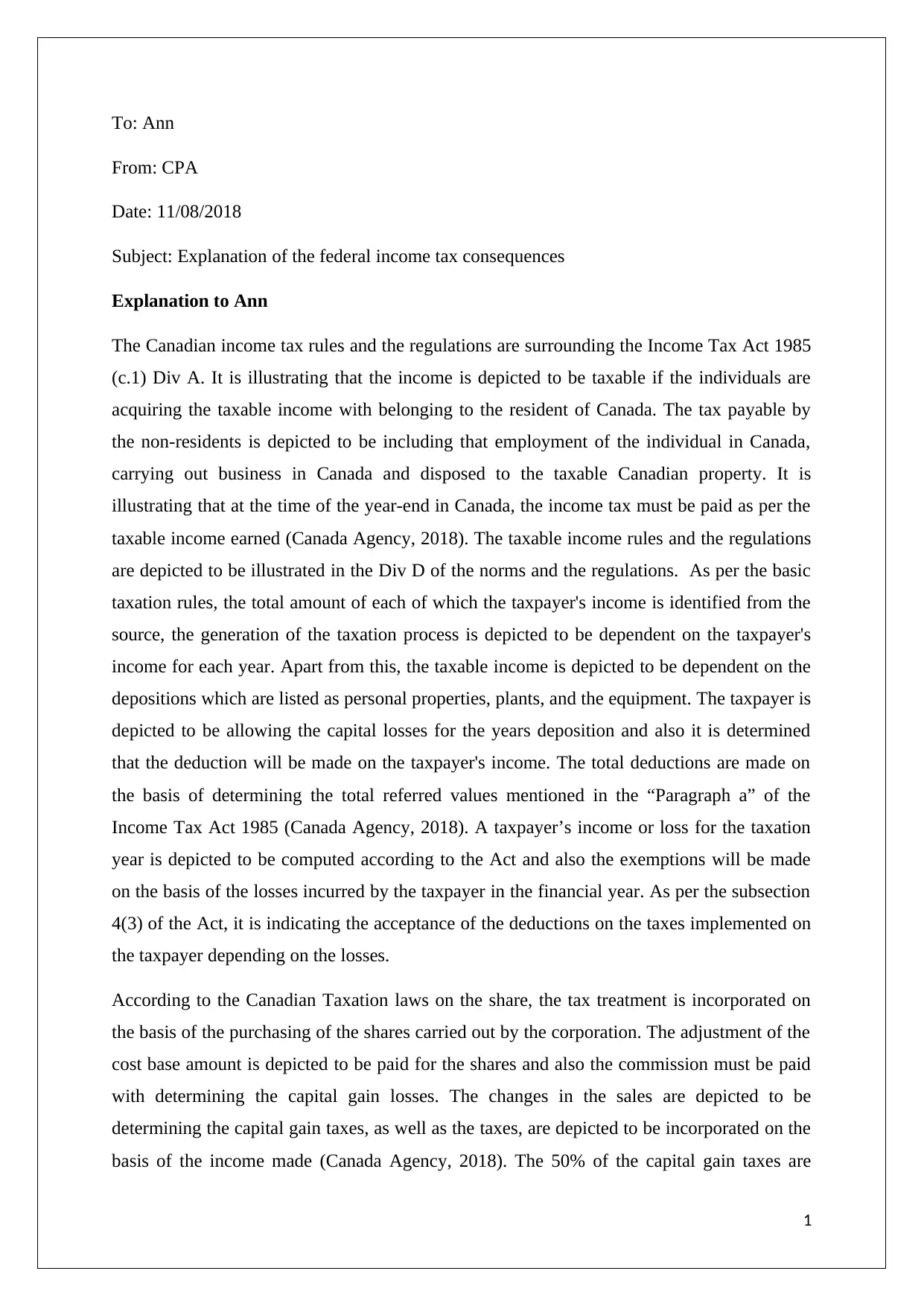
To: Ann
From: CPA
Date: 11/08/2018
Subject: Explanation of the federal income tax consequences
Explanation to Ann
The Canadian income tax rules and the regulations are surrounding the Income Tax Act 1985
(c.1) Div A. It is illustrating that the income is depicted to be taxable if the individuals are
acquiring the taxable income with belonging to the resident of Canada. The tax payable by
the non-residents is depicted to be including that employment of the individual in Canada,
carrying out business in Canada and disposed to the taxable Canadian property. It is
illustrating that at the time of the year-end in Canada, the income tax must be paid as per the
taxable income earned (Canada Agency, 2018). The taxable income rules and the regulations
are depicted to be illustrated in the Div D of the norms and the regulations. As per the basic
taxation rules, the total amount of each of which the taxpayer's income is identified from the
source, the generation of the taxation process is depicted to be dependent on the taxpayer's
income for each year. Apart from this, the taxable income is depicted to be dependent on the
depositions which are listed as personal properties, plants, and the equipment. The taxpayer is
depicted to be allowing the capital losses for the years deposition and also it is determined
that the deduction will be made on the taxpayer's income. The total deductions are made on
the basis of determining the total referred values mentioned in the “Paragraph a” of the
Income Tax Act 1985 (Canada Agency, 2018). A taxpayer’s income or loss for the taxation
year is depicted to be computed according to the Act and also the exemptions will be made
on the basis of the losses incurred by the taxpayer in the financial year. As per the subsection
4(3) of the Act, it is indicating the acceptance of the deductions on the taxes implemented on
the taxpayer depending on the losses.
According to the Canadian Taxation laws on the share, the tax treatment is incorporated on
the basis of the purchasing of the shares carried out by the corporation. The adjustment of the
cost base amount is depicted to be paid for the shares and also the commission must be paid
with determining the capital gain losses. The changes in the sales are depicted to be
determining the capital gain taxes, as well as the taxes, are depicted to be incorporated on the
basis of the income made (Canada Agency, 2018). The 50% of the capital gain taxes are
1
From: CPA
Date: 11/08/2018
Subject: Explanation of the federal income tax consequences
Explanation to Ann
The Canadian income tax rules and the regulations are surrounding the Income Tax Act 1985
(c.1) Div A. It is illustrating that the income is depicted to be taxable if the individuals are
acquiring the taxable income with belonging to the resident of Canada. The tax payable by
the non-residents is depicted to be including that employment of the individual in Canada,
carrying out business in Canada and disposed to the taxable Canadian property. It is
illustrating that at the time of the year-end in Canada, the income tax must be paid as per the
taxable income earned (Canada Agency, 2018). The taxable income rules and the regulations
are depicted to be illustrated in the Div D of the norms and the regulations. As per the basic
taxation rules, the total amount of each of which the taxpayer's income is identified from the
source, the generation of the taxation process is depicted to be dependent on the taxpayer's
income for each year. Apart from this, the taxable income is depicted to be dependent on the
depositions which are listed as personal properties, plants, and the equipment. The taxpayer is
depicted to be allowing the capital losses for the years deposition and also it is determined
that the deduction will be made on the taxpayer's income. The total deductions are made on
the basis of determining the total referred values mentioned in the “Paragraph a” of the
Income Tax Act 1985 (Canada Agency, 2018). A taxpayer’s income or loss for the taxation
year is depicted to be computed according to the Act and also the exemptions will be made
on the basis of the losses incurred by the taxpayer in the financial year. As per the subsection
4(3) of the Act, it is indicating the acceptance of the deductions on the taxes implemented on
the taxpayer depending on the losses.
According to the Canadian Taxation laws on the share, the tax treatment is incorporated on
the basis of the purchasing of the shares carried out by the corporation. The adjustment of the
cost base amount is depicted to be paid for the shares and also the commission must be paid
with determining the capital gain losses. The changes in the sales are depicted to be
determining the capital gain taxes, as well as the taxes, are depicted to be incorporated on the
basis of the income made (Canada Agency, 2018). The 50% of the capital gain taxes are
1
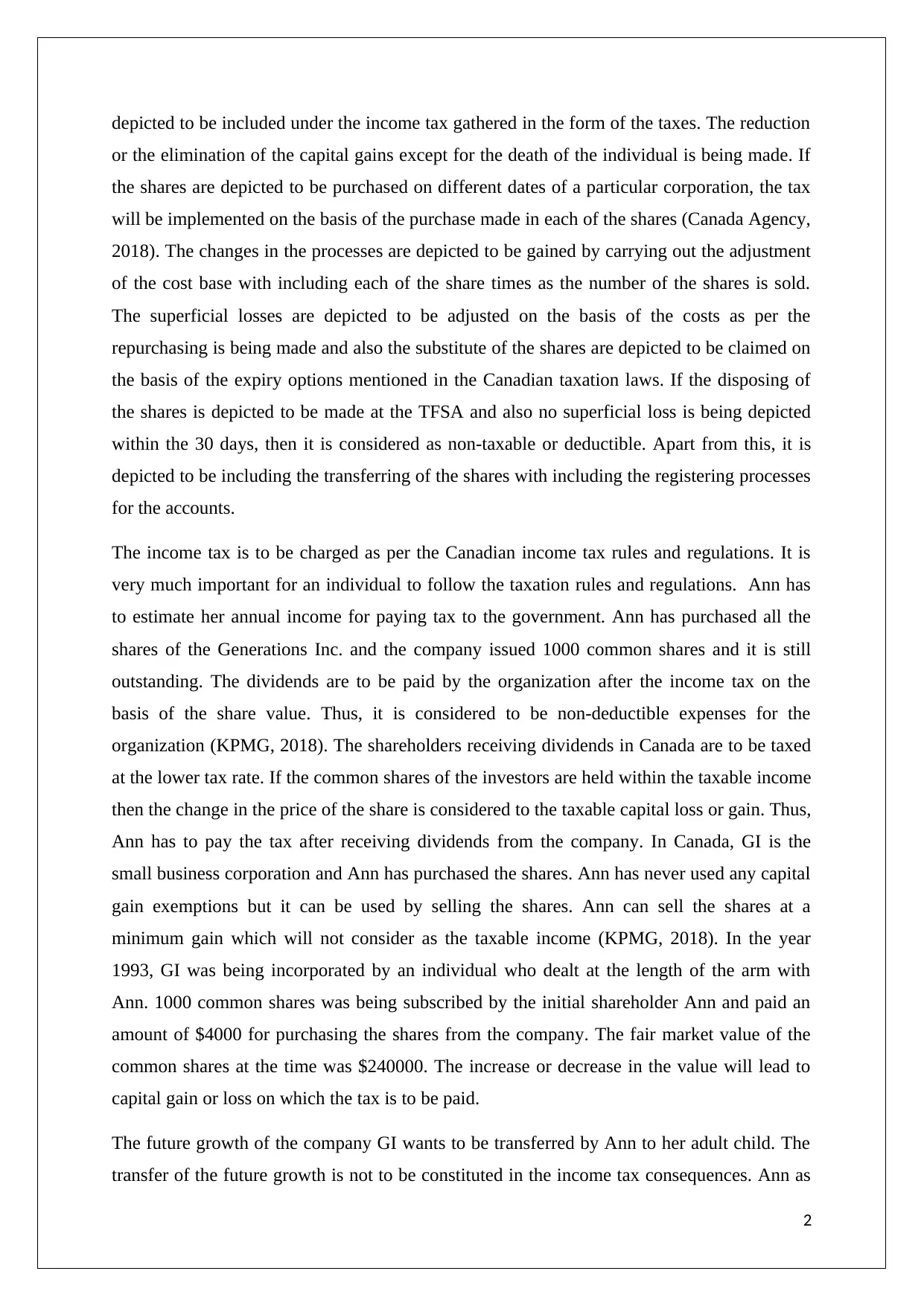
depicted to be included under the income tax gathered in the form of the taxes. The reduction
or the elimination of the capital gains except for the death of the individual is being made. If
the shares are depicted to be purchased on different dates of a particular corporation, the tax
will be implemented on the basis of the purchase made in each of the shares (Canada Agency,
2018). The changes in the processes are depicted to be gained by carrying out the adjustment
of the cost base with including each of the share times as the number of the shares is sold.
The superficial losses are depicted to be adjusted on the basis of the costs as per the
repurchasing is being made and also the substitute of the shares are depicted to be claimed on
the basis of the expiry options mentioned in the Canadian taxation laws. If the disposing of
the shares is depicted to be made at the TFSA and also no superficial loss is being depicted
within the 30 days, then it is considered as non-taxable or deductible. Apart from this, it is
depicted to be including the transferring of the shares with including the registering processes
for the accounts.
The income tax is to be charged as per the Canadian income tax rules and regulations. It is
very much important for an individual to follow the taxation rules and regulations. Ann has
to estimate her annual income for paying tax to the government. Ann has purchased all the
shares of the Generations Inc. and the company issued 1000 common shares and it is still
outstanding. The dividends are to be paid by the organization after the income tax on the
basis of the share value. Thus, it is considered to be non-deductible expenses for the
organization (KPMG, 2018). The shareholders receiving dividends in Canada are to be taxed
at the lower tax rate. If the common shares of the investors are held within the taxable income
then the change in the price of the share is considered to the taxable capital loss or gain. Thus,
Ann has to pay the tax after receiving dividends from the company. In Canada, GI is the
small business corporation and Ann has purchased the shares. Ann has never used any capital
gain exemptions but it can be used by selling the shares. Ann can sell the shares at a
minimum gain which will not consider as the taxable income (KPMG, 2018). In the year
1993, GI was being incorporated by an individual who dealt at the length of the arm with
Ann. 1000 common shares was being subscribed by the initial shareholder Ann and paid an
amount of $4000 for purchasing the shares from the company. The fair market value of the
common shares at the time was $240000. The increase or decrease in the value will lead to
capital gain or loss on which the tax is to be paid.
The future growth of the company GI wants to be transferred by Ann to her adult child. The
transfer of the future growth is not to be constituted in the income tax consequences. Ann as
2
or the elimination of the capital gains except for the death of the individual is being made. If
the shares are depicted to be purchased on different dates of a particular corporation, the tax
will be implemented on the basis of the purchase made in each of the shares (Canada Agency,
2018). The changes in the processes are depicted to be gained by carrying out the adjustment
of the cost base with including each of the share times as the number of the shares is sold.
The superficial losses are depicted to be adjusted on the basis of the costs as per the
repurchasing is being made and also the substitute of the shares are depicted to be claimed on
the basis of the expiry options mentioned in the Canadian taxation laws. If the disposing of
the shares is depicted to be made at the TFSA and also no superficial loss is being depicted
within the 30 days, then it is considered as non-taxable or deductible. Apart from this, it is
depicted to be including the transferring of the shares with including the registering processes
for the accounts.
The income tax is to be charged as per the Canadian income tax rules and regulations. It is
very much important for an individual to follow the taxation rules and regulations. Ann has
to estimate her annual income for paying tax to the government. Ann has purchased all the
shares of the Generations Inc. and the company issued 1000 common shares and it is still
outstanding. The dividends are to be paid by the organization after the income tax on the
basis of the share value. Thus, it is considered to be non-deductible expenses for the
organization (KPMG, 2018). The shareholders receiving dividends in Canada are to be taxed
at the lower tax rate. If the common shares of the investors are held within the taxable income
then the change in the price of the share is considered to the taxable capital loss or gain. Thus,
Ann has to pay the tax after receiving dividends from the company. In Canada, GI is the
small business corporation and Ann has purchased the shares. Ann has never used any capital
gain exemptions but it can be used by selling the shares. Ann can sell the shares at a
minimum gain which will not consider as the taxable income (KPMG, 2018). In the year
1993, GI was being incorporated by an individual who dealt at the length of the arm with
Ann. 1000 common shares was being subscribed by the initial shareholder Ann and paid an
amount of $4000 for purchasing the shares from the company. The fair market value of the
common shares at the time was $240000. The increase or decrease in the value will lead to
capital gain or loss on which the tax is to be paid.
The future growth of the company GI wants to be transferred by Ann to her adult child. The
transfer of the future growth is not to be constituted in the income tax consequences. Ann as
2
⊘ This is a preview!⊘
Do you want full access?
Subscribe today to unlock all pages.

Trusted by 1+ million students worldwide
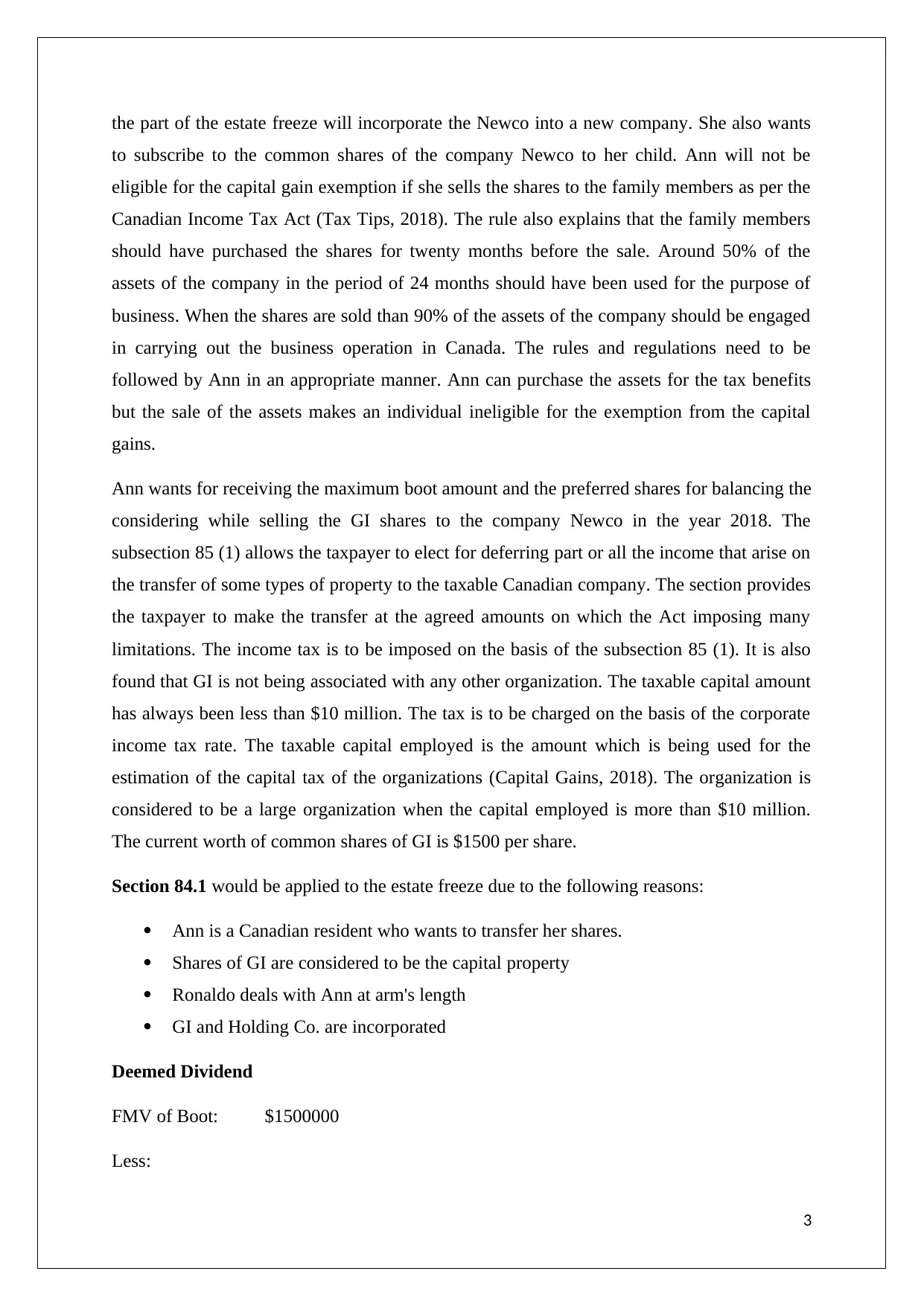
the part of the estate freeze will incorporate the Newco into a new company. She also wants
to subscribe to the common shares of the company Newco to her child. Ann will not be
eligible for the capital gain exemption if she sells the shares to the family members as per the
Canadian Income Tax Act (Tax Tips, 2018). The rule also explains that the family members
should have purchased the shares for twenty months before the sale. Around 50% of the
assets of the company in the period of 24 months should have been used for the purpose of
business. When the shares are sold than 90% of the assets of the company should be engaged
in carrying out the business operation in Canada. The rules and regulations need to be
followed by Ann in an appropriate manner. Ann can purchase the assets for the tax benefits
but the sale of the assets makes an individual ineligible for the exemption from the capital
gains.
Ann wants for receiving the maximum boot amount and the preferred shares for balancing the
considering while selling the GI shares to the company Newco in the year 2018. The
subsection 85 (1) allows the taxpayer to elect for deferring part or all the income that arise on
the transfer of some types of property to the taxable Canadian company. The section provides
the taxpayer to make the transfer at the agreed amounts on which the Act imposing many
limitations. The income tax is to be imposed on the basis of the subsection 85 (1). It is also
found that GI is not being associated with any other organization. The taxable capital amount
has always been less than $10 million. The tax is to be charged on the basis of the corporate
income tax rate. The taxable capital employed is the amount which is being used for the
estimation of the capital tax of the organizations (Capital Gains, 2018). The organization is
considered to be a large organization when the capital employed is more than $10 million.
The current worth of common shares of GI is $1500 per share.
Section 84.1 would be applied to the estate freeze due to the following reasons:
Ann is a Canadian resident who wants to transfer her shares.
Shares of GI are considered to be the capital property
Ronaldo deals with Ann at arm's length
GI and Holding Co. are incorporated
Deemed Dividend
FMV of Boot: $1500000
Less:
3
to subscribe to the common shares of the company Newco to her child. Ann will not be
eligible for the capital gain exemption if she sells the shares to the family members as per the
Canadian Income Tax Act (Tax Tips, 2018). The rule also explains that the family members
should have purchased the shares for twenty months before the sale. Around 50% of the
assets of the company in the period of 24 months should have been used for the purpose of
business. When the shares are sold than 90% of the assets of the company should be engaged
in carrying out the business operation in Canada. The rules and regulations need to be
followed by Ann in an appropriate manner. Ann can purchase the assets for the tax benefits
but the sale of the assets makes an individual ineligible for the exemption from the capital
gains.
Ann wants for receiving the maximum boot amount and the preferred shares for balancing the
considering while selling the GI shares to the company Newco in the year 2018. The
subsection 85 (1) allows the taxpayer to elect for deferring part or all the income that arise on
the transfer of some types of property to the taxable Canadian company. The section provides
the taxpayer to make the transfer at the agreed amounts on which the Act imposing many
limitations. The income tax is to be imposed on the basis of the subsection 85 (1). It is also
found that GI is not being associated with any other organization. The taxable capital amount
has always been less than $10 million. The tax is to be charged on the basis of the corporate
income tax rate. The taxable capital employed is the amount which is being used for the
estimation of the capital tax of the organizations (Capital Gains, 2018). The organization is
considered to be a large organization when the capital employed is more than $10 million.
The current worth of common shares of GI is $1500 per share.
Section 84.1 would be applied to the estate freeze due to the following reasons:
Ann is a Canadian resident who wants to transfer her shares.
Shares of GI are considered to be the capital property
Ronaldo deals with Ann at arm's length
GI and Holding Co. are incorporated
Deemed Dividend
FMV of Boot: $1500000
Less:
3
Paraphrase This Document
Need a fresh take? Get an instant paraphrase of this document with our AI Paraphraser
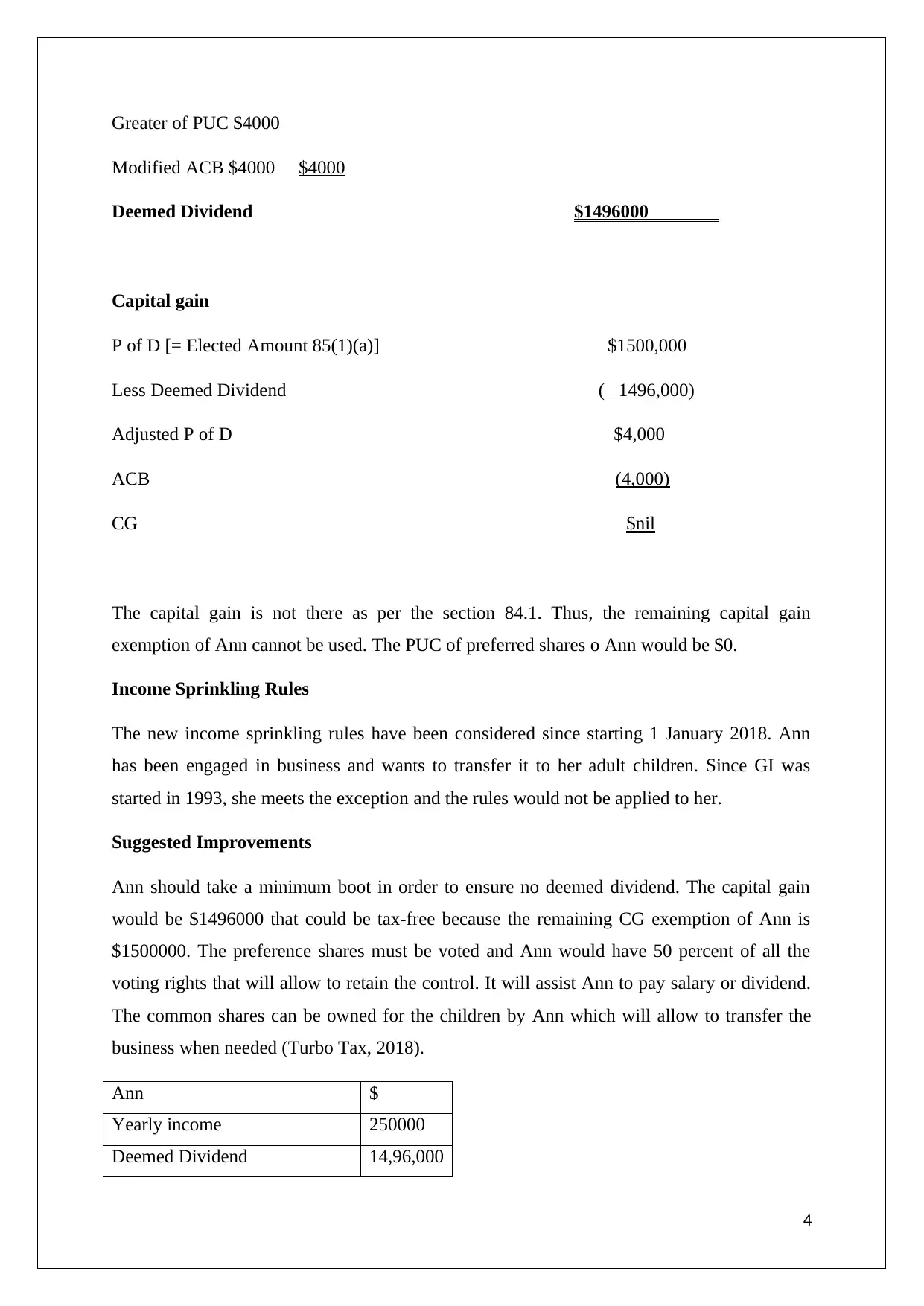
Greater of PUC $4000
Modified ACB $4000 $4000
Deemed Dividend $1496000
Capital gain
P of D [= Elected Amount 85(1)(a)] $1500,000
Less Deemed Dividend ( 1496,000)
Adjusted P of D $4,000
ACB (4,000)
CG $nil
The capital gain is not there as per the section 84.1. Thus, the remaining capital gain
exemption of Ann cannot be used. The PUC of preferred shares o Ann would be $0.
Income Sprinkling Rules
The new income sprinkling rules have been considered since starting 1 January 2018. Ann
has been engaged in business and wants to transfer it to her adult children. Since GI was
started in 1993, she meets the exception and the rules would not be applied to her.
Suggested Improvements
Ann should take a minimum boot in order to ensure no deemed dividend. The capital gain
would be $1496000 that could be tax-free because the remaining CG exemption of Ann is
$1500000. The preference shares must be voted and Ann would have 50 percent of all the
voting rights that will allow to retain the control. It will assist Ann to pay salary or dividend.
The common shares can be owned for the children by Ann which will allow to transfer the
business when needed (Turbo Tax, 2018).
Ann $
Yearly income 250000
Deemed Dividend 14,96,000
4
Modified ACB $4000 $4000
Deemed Dividend $1496000
Capital gain
P of D [= Elected Amount 85(1)(a)] $1500,000
Less Deemed Dividend ( 1496,000)
Adjusted P of D $4,000
ACB (4,000)
CG $nil
The capital gain is not there as per the section 84.1. Thus, the remaining capital gain
exemption of Ann cannot be used. The PUC of preferred shares o Ann would be $0.
Income Sprinkling Rules
The new income sprinkling rules have been considered since starting 1 January 2018. Ann
has been engaged in business and wants to transfer it to her adult children. Since GI was
started in 1993, she meets the exception and the rules would not be applied to her.
Suggested Improvements
Ann should take a minimum boot in order to ensure no deemed dividend. The capital gain
would be $1496000 that could be tax-free because the remaining CG exemption of Ann is
$1500000. The preference shares must be voted and Ann would have 50 percent of all the
voting rights that will allow to retain the control. It will assist Ann to pay salary or dividend.
The common shares can be owned for the children by Ann which will allow to transfer the
business when needed (Turbo Tax, 2018).
Ann $
Yearly income 250000
Deemed Dividend 14,96,000
4
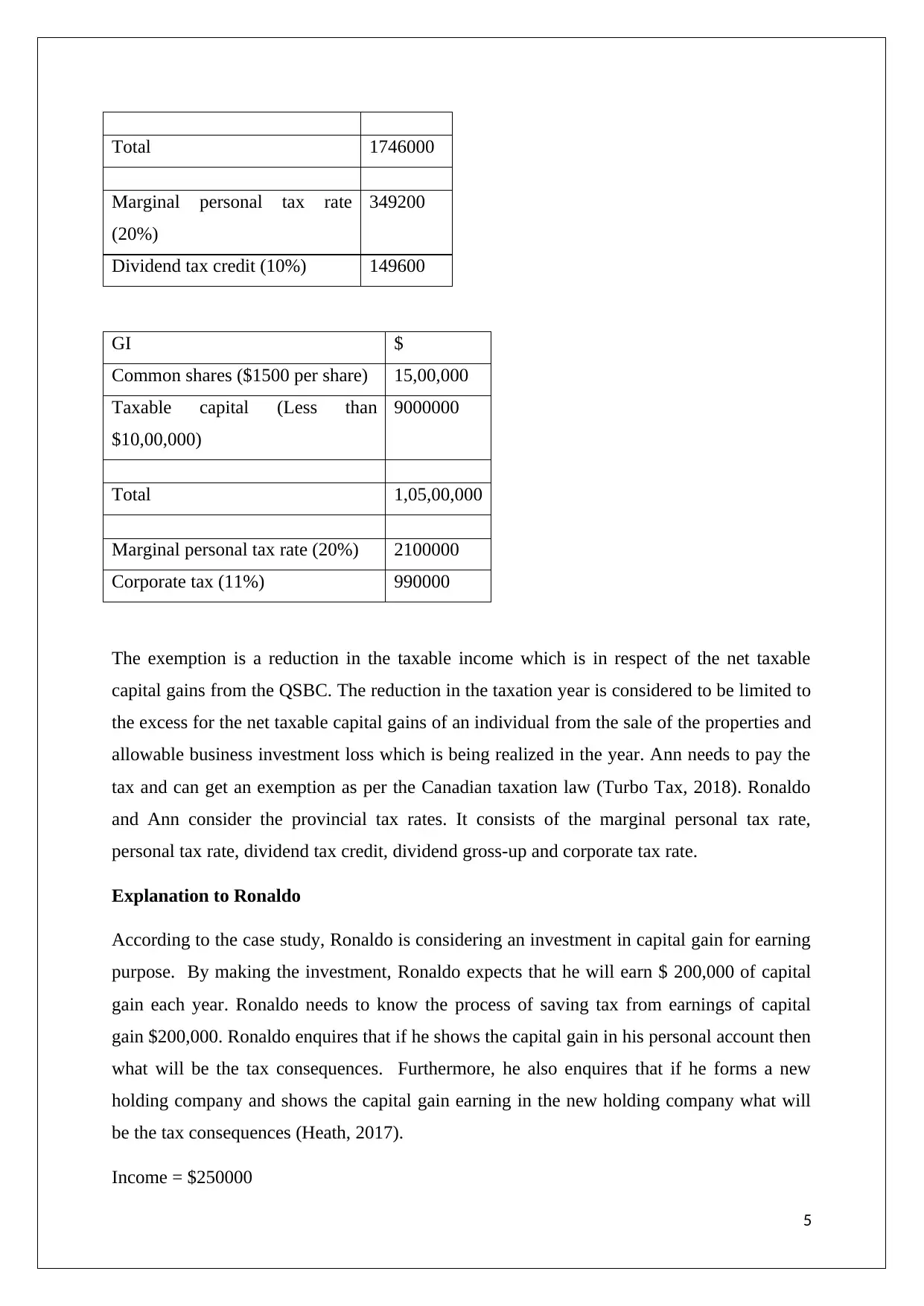
Total 1746000
Marginal personal tax rate
(20%)
349200
Dividend tax credit (10%) 149600
GI $
Common shares ($1500 per share) 15,00,000
Taxable capital (Less than
$10,00,000)
9000000
Total 1,05,00,000
Marginal personal tax rate (20%) 2100000
Corporate tax (11%) 990000
The exemption is a reduction in the taxable income which is in respect of the net taxable
capital gains from the QSBC. The reduction in the taxation year is considered to be limited to
the excess for the net taxable capital gains of an individual from the sale of the properties and
allowable business investment loss which is being realized in the year. Ann needs to pay the
tax and can get an exemption as per the Canadian taxation law (Turbo Tax, 2018). Ronaldo
and Ann consider the provincial tax rates. It consists of the marginal personal tax rate,
personal tax rate, dividend tax credit, dividend gross-up and corporate tax rate.
Explanation to Ronaldo
According to the case study, Ronaldo is considering an investment in capital gain for earning
purpose. By making the investment, Ronaldo expects that he will earn $ 200,000 of capital
gain each year. Ronaldo needs to know the process of saving tax from earnings of capital
gain $200,000. Ronaldo enquires that if he shows the capital gain in his personal account then
what will be the tax consequences. Furthermore, he also enquires that if he forms a new
holding company and shows the capital gain earning in the new holding company what will
be the tax consequences (Heath, 2017).
Income = $250000
5
Marginal personal tax rate
(20%)
349200
Dividend tax credit (10%) 149600
GI $
Common shares ($1500 per share) 15,00,000
Taxable capital (Less than
$10,00,000)
9000000
Total 1,05,00,000
Marginal personal tax rate (20%) 2100000
Corporate tax (11%) 990000
The exemption is a reduction in the taxable income which is in respect of the net taxable
capital gains from the QSBC. The reduction in the taxation year is considered to be limited to
the excess for the net taxable capital gains of an individual from the sale of the properties and
allowable business investment loss which is being realized in the year. Ann needs to pay the
tax and can get an exemption as per the Canadian taxation law (Turbo Tax, 2018). Ronaldo
and Ann consider the provincial tax rates. It consists of the marginal personal tax rate,
personal tax rate, dividend tax credit, dividend gross-up and corporate tax rate.
Explanation to Ronaldo
According to the case study, Ronaldo is considering an investment in capital gain for earning
purpose. By making the investment, Ronaldo expects that he will earn $ 200,000 of capital
gain each year. Ronaldo needs to know the process of saving tax from earnings of capital
gain $200,000. Ronaldo enquires that if he shows the capital gain in his personal account then
what will be the tax consequences. Furthermore, he also enquires that if he forms a new
holding company and shows the capital gain earning in the new holding company what will
be the tax consequences (Heath, 2017).
Income = $250000
5
⊘ This is a preview!⊘
Do you want full access?
Subscribe today to unlock all pages.

Trusted by 1+ million students worldwide
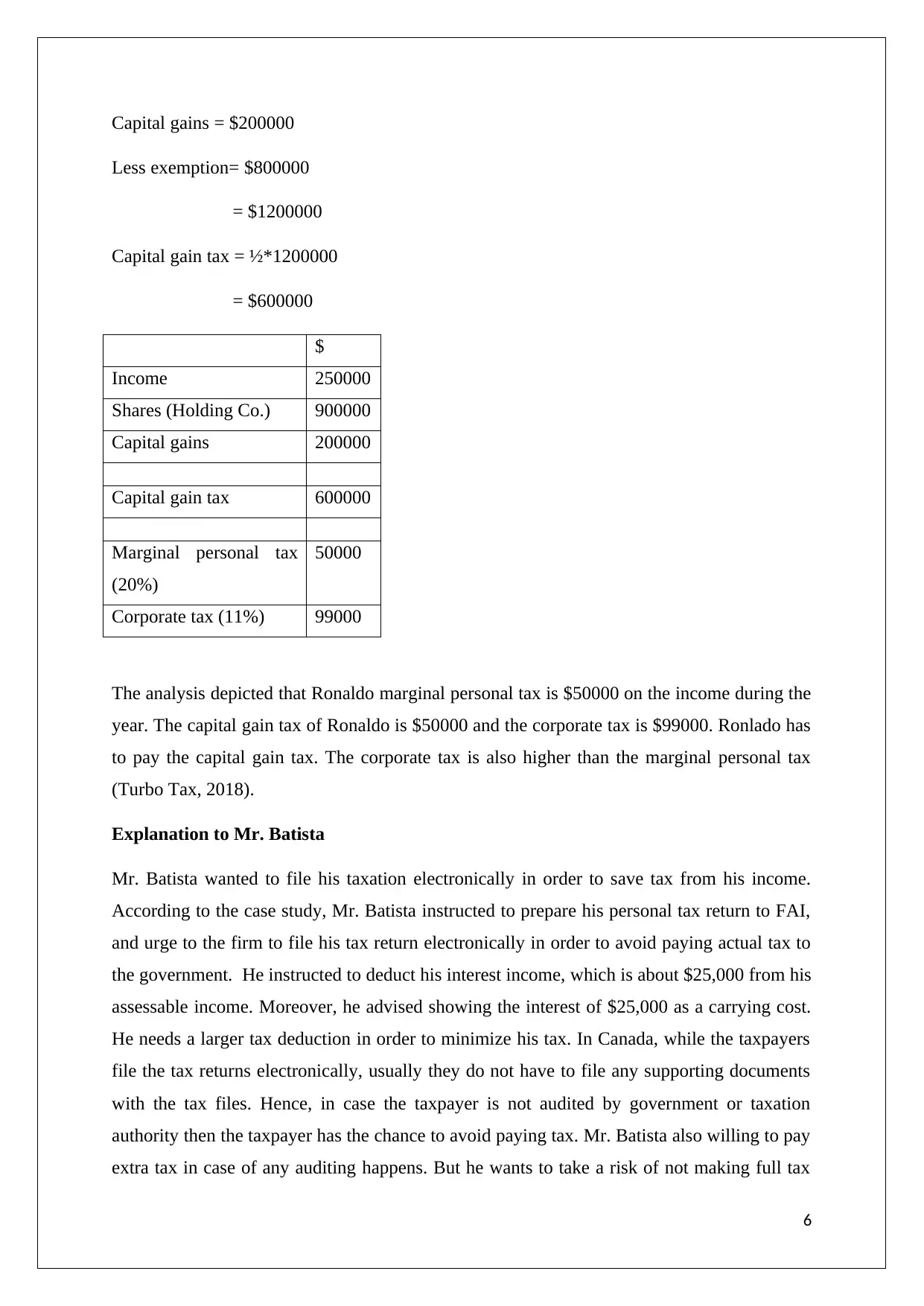
Capital gains = $200000
Less exemption= $800000
= $1200000
Capital gain tax = ½*1200000
= $600000
$
Income 250000
Shares (Holding Co.) 900000
Capital gains 200000
Capital gain tax 600000
Marginal personal tax
(20%)
50000
Corporate tax (11%) 99000
The analysis depicted that Ronaldo marginal personal tax is $50000 on the income during the
year. The capital gain tax of Ronaldo is $50000 and the corporate tax is $99000. Ronlado has
to pay the capital gain tax. The corporate tax is also higher than the marginal personal tax
(Turbo Tax, 2018).
Explanation to Mr. Batista
Mr. Batista wanted to file his taxation electronically in order to save tax from his income.
According to the case study, Mr. Batista instructed to prepare his personal tax return to FAI,
and urge to the firm to file his tax return electronically in order to avoid paying actual tax to
the government. He instructed to deduct his interest income, which is about $25,000 from his
assessable income. Moreover, he advised showing the interest of $25,000 as a carrying cost.
He needs a larger tax deduction in order to minimize his tax. In Canada, while the taxpayers
file the tax returns electronically, usually they do not have to file any supporting documents
with the tax files. Hence, in case the taxpayer is not audited by government or taxation
authority then the taxpayer has the chance to avoid paying tax. Mr. Batista also willing to pay
extra tax in case of any auditing happens. But he wants to take a risk of not making full tax
6
Less exemption= $800000
= $1200000
Capital gain tax = ½*1200000
= $600000
$
Income 250000
Shares (Holding Co.) 900000
Capital gains 200000
Capital gain tax 600000
Marginal personal tax
(20%)
50000
Corporate tax (11%) 99000
The analysis depicted that Ronaldo marginal personal tax is $50000 on the income during the
year. The capital gain tax of Ronaldo is $50000 and the corporate tax is $99000. Ronlado has
to pay the capital gain tax. The corporate tax is also higher than the marginal personal tax
(Turbo Tax, 2018).
Explanation to Mr. Batista
Mr. Batista wanted to file his taxation electronically in order to save tax from his income.
According to the case study, Mr. Batista instructed to prepare his personal tax return to FAI,
and urge to the firm to file his tax return electronically in order to avoid paying actual tax to
the government. He instructed to deduct his interest income, which is about $25,000 from his
assessable income. Moreover, he advised showing the interest of $25,000 as a carrying cost.
He needs a larger tax deduction in order to minimize his tax. In Canada, while the taxpayers
file the tax returns electronically, usually they do not have to file any supporting documents
with the tax files. Hence, in case the taxpayer is not audited by government or taxation
authority then the taxpayer has the chance to avoid paying tax. Mr. Batista also willing to pay
extra tax in case of any auditing happens. But he wants to take a risk of not making full tax
6
Paraphrase This Document
Need a fresh take? Get an instant paraphrase of this document with our AI Paraphraser
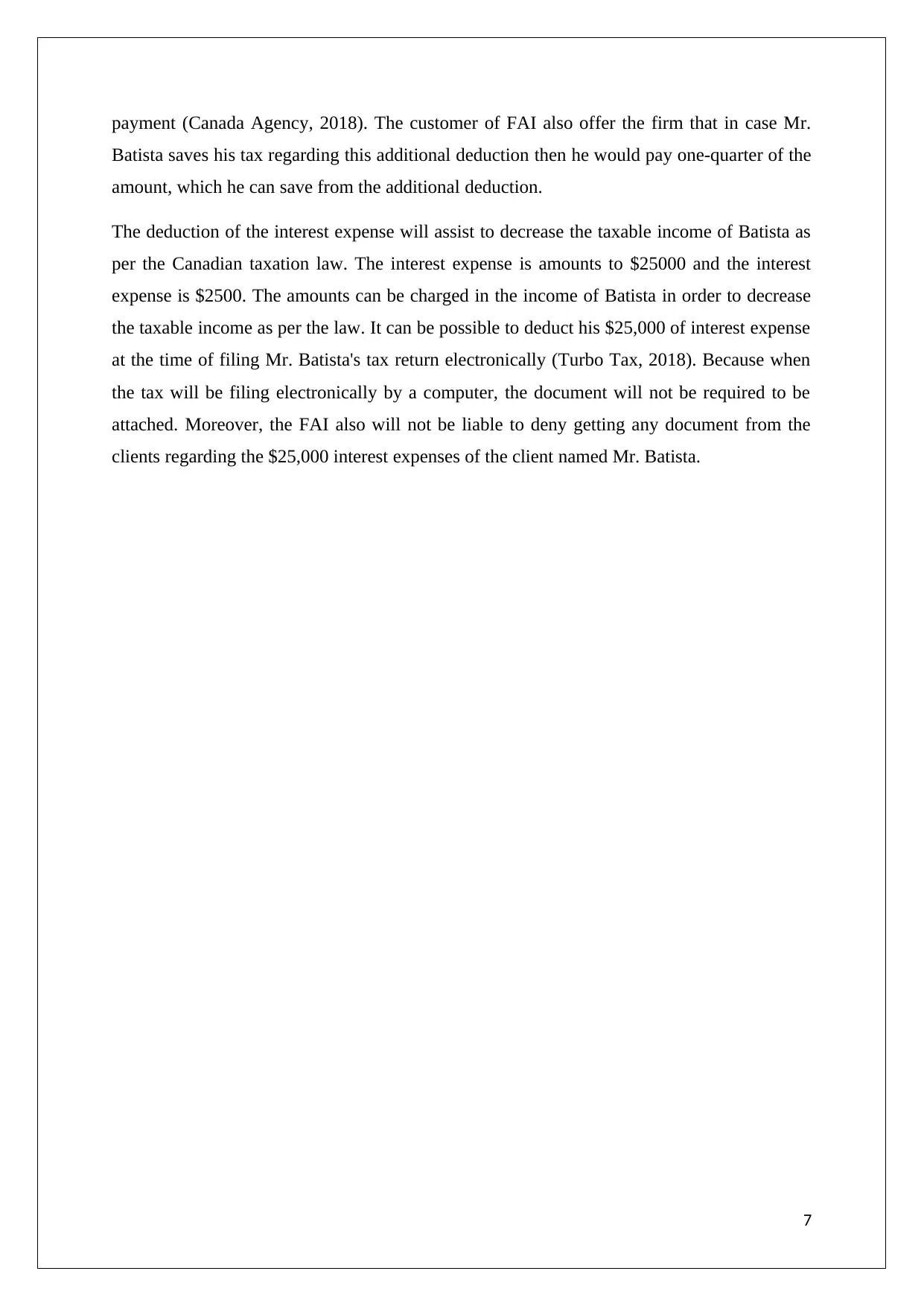
payment (Canada Agency, 2018). The customer of FAI also offer the firm that in case Mr.
Batista saves his tax regarding this additional deduction then he would pay one-quarter of the
amount, which he can save from the additional deduction.
The deduction of the interest expense will assist to decrease the taxable income of Batista as
per the Canadian taxation law. The interest expense is amounts to $25000 and the interest
expense is $2500. The amounts can be charged in the income of Batista in order to decrease
the taxable income as per the law. It can be possible to deduct his $25,000 of interest expense
at the time of filing Mr. Batista's tax return electronically (Turbo Tax, 2018). Because when
the tax will be filing electronically by a computer, the document will not be required to be
attached. Moreover, the FAI also will not be liable to deny getting any document from the
clients regarding the $25,000 interest expenses of the client named Mr. Batista.
7
Batista saves his tax regarding this additional deduction then he would pay one-quarter of the
amount, which he can save from the additional deduction.
The deduction of the interest expense will assist to decrease the taxable income of Batista as
per the Canadian taxation law. The interest expense is amounts to $25000 and the interest
expense is $2500. The amounts can be charged in the income of Batista in order to decrease
the taxable income as per the law. It can be possible to deduct his $25,000 of interest expense
at the time of filing Mr. Batista's tax return electronically (Turbo Tax, 2018). Because when
the tax will be filing electronically by a computer, the document will not be required to be
attached. Moreover, the FAI also will not be liable to deny getting any document from the
clients regarding the $25,000 interest expenses of the client named Mr. Batista.
7
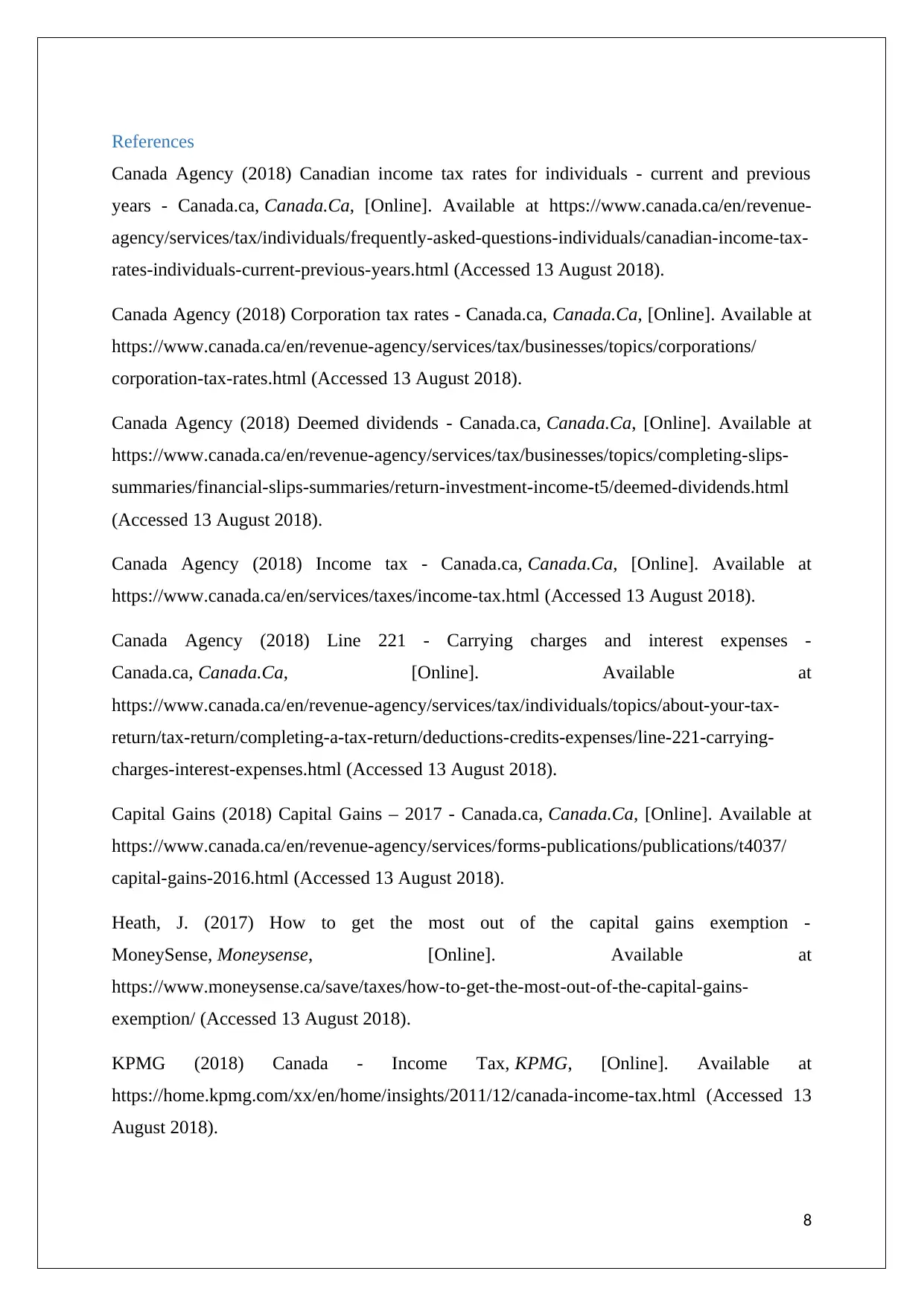
References
Canada Agency (2018) Canadian income tax rates for individuals - current and previous
years - Canada.ca, Canada.Ca, [Online]. Available at https://www.canada.ca/en/revenue-
agency/services/tax/individuals/frequently-asked-questions-individuals/canadian-income-tax-
rates-individuals-current-previous-years.html (Accessed 13 August 2018).
Canada Agency (2018) Corporation tax rates - Canada.ca, Canada.Ca, [Online]. Available at
https://www.canada.ca/en/revenue-agency/services/tax/businesses/topics/corporations/
corporation-tax-rates.html (Accessed 13 August 2018).
Canada Agency (2018) Deemed dividends - Canada.ca, Canada.Ca, [Online]. Available at
https://www.canada.ca/en/revenue-agency/services/tax/businesses/topics/completing-slips-
summaries/financial-slips-summaries/return-investment-income-t5/deemed-dividends.html
(Accessed 13 August 2018).
Canada Agency (2018) Income tax - Canada.ca, Canada.Ca, [Online]. Available at
https://www.canada.ca/en/services/taxes/income-tax.html (Accessed 13 August 2018).
Canada Agency (2018) Line 221 - Carrying charges and interest expenses -
Canada.ca, Canada.Ca, [Online]. Available at
https://www.canada.ca/en/revenue-agency/services/tax/individuals/topics/about-your-tax-
return/tax-return/completing-a-tax-return/deductions-credits-expenses/line-221-carrying-
charges-interest-expenses.html (Accessed 13 August 2018).
Capital Gains (2018) Capital Gains – 2017 - Canada.ca, Canada.Ca, [Online]. Available at
https://www.canada.ca/en/revenue-agency/services/forms-publications/publications/t4037/
capital-gains-2016.html (Accessed 13 August 2018).
Heath, J. (2017) How to get the most out of the capital gains exemption -
MoneySense, Moneysense, [Online]. Available at
https://www.moneysense.ca/save/taxes/how-to-get-the-most-out-of-the-capital-gains-
exemption/ (Accessed 13 August 2018).
KPMG (2018) Canada - Income Tax, KPMG, [Online]. Available at
https://home.kpmg.com/xx/en/home/insights/2011/12/canada-income-tax.html (Accessed 13
August 2018).
8
Canada Agency (2018) Canadian income tax rates for individuals - current and previous
years - Canada.ca, Canada.Ca, [Online]. Available at https://www.canada.ca/en/revenue-
agency/services/tax/individuals/frequently-asked-questions-individuals/canadian-income-tax-
rates-individuals-current-previous-years.html (Accessed 13 August 2018).
Canada Agency (2018) Corporation tax rates - Canada.ca, Canada.Ca, [Online]. Available at
https://www.canada.ca/en/revenue-agency/services/tax/businesses/topics/corporations/
corporation-tax-rates.html (Accessed 13 August 2018).
Canada Agency (2018) Deemed dividends - Canada.ca, Canada.Ca, [Online]. Available at
https://www.canada.ca/en/revenue-agency/services/tax/businesses/topics/completing-slips-
summaries/financial-slips-summaries/return-investment-income-t5/deemed-dividends.html
(Accessed 13 August 2018).
Canada Agency (2018) Income tax - Canada.ca, Canada.Ca, [Online]. Available at
https://www.canada.ca/en/services/taxes/income-tax.html (Accessed 13 August 2018).
Canada Agency (2018) Line 221 - Carrying charges and interest expenses -
Canada.ca, Canada.Ca, [Online]. Available at
https://www.canada.ca/en/revenue-agency/services/tax/individuals/topics/about-your-tax-
return/tax-return/completing-a-tax-return/deductions-credits-expenses/line-221-carrying-
charges-interest-expenses.html (Accessed 13 August 2018).
Capital Gains (2018) Capital Gains – 2017 - Canada.ca, Canada.Ca, [Online]. Available at
https://www.canada.ca/en/revenue-agency/services/forms-publications/publications/t4037/
capital-gains-2016.html (Accessed 13 August 2018).
Heath, J. (2017) How to get the most out of the capital gains exemption -
MoneySense, Moneysense, [Online]. Available at
https://www.moneysense.ca/save/taxes/how-to-get-the-most-out-of-the-capital-gains-
exemption/ (Accessed 13 August 2018).
KPMG (2018) Canada - Income Tax, KPMG, [Online]. Available at
https://home.kpmg.com/xx/en/home/insights/2011/12/canada-income-tax.html (Accessed 13
August 2018).
8
⊘ This is a preview!⊘
Do you want full access?
Subscribe today to unlock all pages.

Trusted by 1+ million students worldwide
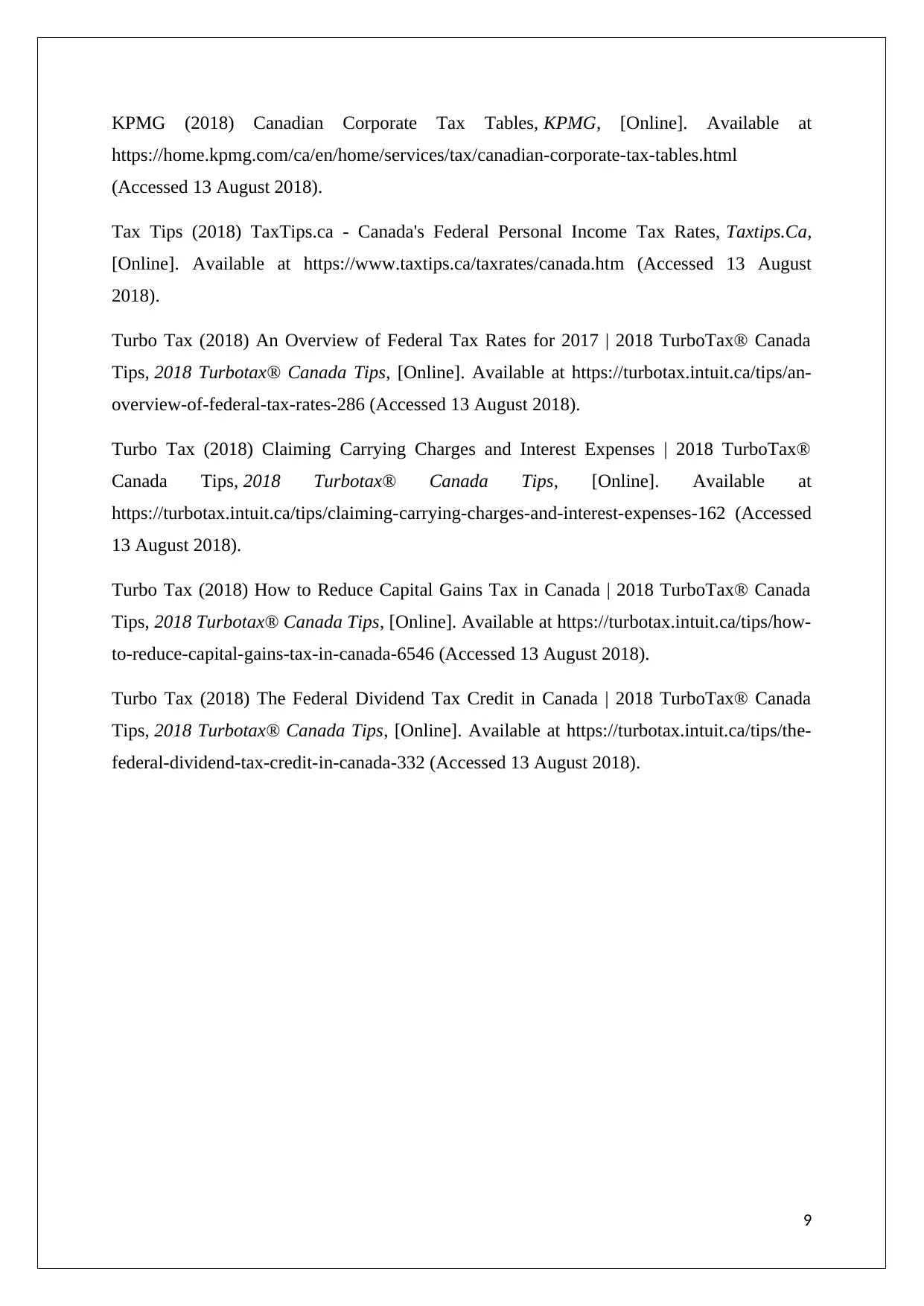
KPMG (2018) Canadian Corporate Tax Tables, KPMG, [Online]. Available at
https://home.kpmg.com/ca/en/home/services/tax/canadian-corporate-tax-tables.html
(Accessed 13 August 2018).
Tax Tips (2018) TaxTips.ca - Canada's Federal Personal Income Tax Rates, Taxtips.Ca,
[Online]. Available at https://www.taxtips.ca/taxrates/canada.htm (Accessed 13 August
2018).
Turbo Tax (2018) An Overview of Federal Tax Rates for 2017 | 2018 TurboTax® Canada
Tips, 2018 Turbotax® Canada Tips, [Online]. Available at https://turbotax.intuit.ca/tips/an-
overview-of-federal-tax-rates-286 (Accessed 13 August 2018).
Turbo Tax (2018) Claiming Carrying Charges and Interest Expenses | 2018 TurboTax®
Canada Tips, 2018 Turbotax® Canada Tips, [Online]. Available at
https://turbotax.intuit.ca/tips/claiming-carrying-charges-and-interest-expenses-162 (Accessed
13 August 2018).
Turbo Tax (2018) How to Reduce Capital Gains Tax in Canada | 2018 TurboTax® Canada
Tips, 2018 Turbotax® Canada Tips, [Online]. Available at https://turbotax.intuit.ca/tips/how-
to-reduce-capital-gains-tax-in-canada-6546 (Accessed 13 August 2018).
Turbo Tax (2018) The Federal Dividend Tax Credit in Canada | 2018 TurboTax® Canada
Tips, 2018 Turbotax® Canada Tips, [Online]. Available at https://turbotax.intuit.ca/tips/the-
federal-dividend-tax-credit-in-canada-332 (Accessed 13 August 2018).
9
https://home.kpmg.com/ca/en/home/services/tax/canadian-corporate-tax-tables.html
(Accessed 13 August 2018).
Tax Tips (2018) TaxTips.ca - Canada's Federal Personal Income Tax Rates, Taxtips.Ca,
[Online]. Available at https://www.taxtips.ca/taxrates/canada.htm (Accessed 13 August
2018).
Turbo Tax (2018) An Overview of Federal Tax Rates for 2017 | 2018 TurboTax® Canada
Tips, 2018 Turbotax® Canada Tips, [Online]. Available at https://turbotax.intuit.ca/tips/an-
overview-of-federal-tax-rates-286 (Accessed 13 August 2018).
Turbo Tax (2018) Claiming Carrying Charges and Interest Expenses | 2018 TurboTax®
Canada Tips, 2018 Turbotax® Canada Tips, [Online]. Available at
https://turbotax.intuit.ca/tips/claiming-carrying-charges-and-interest-expenses-162 (Accessed
13 August 2018).
Turbo Tax (2018) How to Reduce Capital Gains Tax in Canada | 2018 TurboTax® Canada
Tips, 2018 Turbotax® Canada Tips, [Online]. Available at https://turbotax.intuit.ca/tips/how-
to-reduce-capital-gains-tax-in-canada-6546 (Accessed 13 August 2018).
Turbo Tax (2018) The Federal Dividend Tax Credit in Canada | 2018 TurboTax® Canada
Tips, 2018 Turbotax® Canada Tips, [Online]. Available at https://turbotax.intuit.ca/tips/the-
federal-dividend-tax-credit-in-canada-332 (Accessed 13 August 2018).
9
1 out of 10
Related Documents
Your All-in-One AI-Powered Toolkit for Academic Success.
+13062052269
info@desklib.com
Available 24*7 on WhatsApp / Email
![[object Object]](/_next/static/media/star-bottom.7253800d.svg)
Unlock your academic potential
Copyright © 2020–2025 A2Z Services. All Rights Reserved. Developed and managed by ZUCOL.





